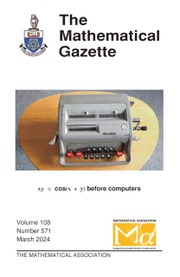No CrossRef data available.
Article contents
The Euler numbers and their last digits
Published online by Cambridge University Press: 20 June 2025
Extract
The Euler numbers are the coefficients En in the expansion
(1)
Since sec x is an even function and tan x an odd one, this decouples into
(2)
and
(3)
where all three series converge if  and E2n + 1 are sometimes called the secant numbers (or secant coefficients) and tangent numbers (or tangent coefficients) respectively.
and E2n + 1 are sometimes called the secant numbers (or secant coefficients) and tangent numbers (or tangent coefficients) respectively.
Information
- Type
- Articles
- Information
- Copyright
- © The Authors, 2025 Published by Cambridge University Press on behalf of The Mathematical Association
References
Euler, Leonhard, Institutiones calculi differentialis, Academiae Imperialis Scientiarum, 1755; Opera Omnia, 1st series, vol. 10, B. G. Teubner, Leipzig, 1913.Google Scholar
Euler, Leonhard, De seriebus quibusdam considerationes, Commentarii academiae scientiarum Petropolitanae 12 (1740), 1750, pp. 53–96; Opera Omnia, 1st series, vol. 14, B. G. Teubner, Leipzig (1925) pp. 407-462.Google Scholar
André, Désiré, Développements de sec x et de tang x, Comptes Rendus hebdomadaires des scéances de l’Academie des sciences 88 (1879), pp. 965–967.Google Scholar
André, Désiré, Sur les permutations alternées, Journal de mathématiques pures et appliquées, 7 (1881) pp. 167–184.Google Scholar
Stanley, Richard P., A survey of alternating permutations (2009), accessed November 2024 at https://arXiv.org/pdf/0912.4240
Google Scholar
Carlitz, Leonard, Enumeration of up-down permutations by number of rises, Pacific Journal of Mathematics 45 (1973) pp. 49–59.CrossRefGoogle Scholar
Carlitz, Leonard, Permutations and sequences, Advances in mathematics 14 (1974) pp. 92–120.CrossRefGoogle Scholar
Carlitz, Leonard, Permutations, sequences, and special functions, SIAM Review 17 (1975) pp. 298–322.CrossRefGoogle Scholar
Carlitz, Leonard and Scoville, Richard, Enumeration of up-down permutations by upper records, Monatshefte für Mathematik 79 (1975) pp. 3–12.CrossRefGoogle Scholar
Moritz Abraham Stern, Zur Theorie der Eulerschen Zahlen, Journal für die reine und angewandte Mathematik 79 (1875) pp. 67–98.Google Scholar
Glaisher, J. W. L., On Eulerian numbers (formulæ, residues, end-figures), with the values of the first twenty-seven, Quarterly Journal of Pure and Applied Mathematics 45 (1914) pp. 1–51.Google Scholar
He, Yuan and Liao, Qunying, Some congruences involving Euler numbers, Fibonacci Quarterly 46/47 (3) (August 2009) pp. 225–234.Google Scholar


